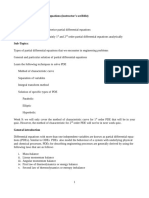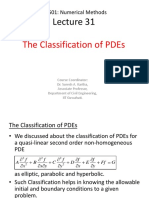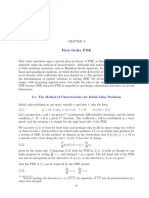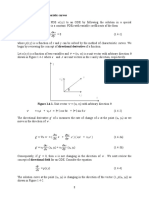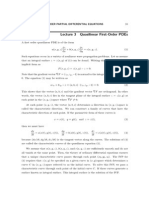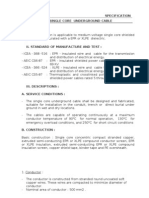0% found this document useful (0 votes)
285 views21 pagesLecture 1 22 Slides
The document describes the method of characteristics for solving quasi-linear partial differential equations (PDEs). The method involves thinking of the graph of the solution surface geometrically and constructing it from the integral curves, or characteristics, of the vector field defined by the PDE. This reduces the problem to a system of ordinary differential equations that can be solved to parametrically describe the solution surface. The method proceeds by parametrizing the initial data curve, solving the characteristic equations, and inverting the parametrization to write the solution explicitly in terms of the independent variables. An example illustrates applying the full method to solve a given quasi-linear PDE.
Uploaded by
NikhilSharmaCopyright
© © All Rights Reserved
We take content rights seriously. If you suspect this is your content, claim it here.
Available Formats
Download as PDF, TXT or read online on Scribd
0% found this document useful (0 votes)
285 views21 pagesLecture 1 22 Slides
The document describes the method of characteristics for solving quasi-linear partial differential equations (PDEs). The method involves thinking of the graph of the solution surface geometrically and constructing it from the integral curves, or characteristics, of the vector field defined by the PDE. This reduces the problem to a system of ordinary differential equations that can be solved to parametrically describe the solution surface. The method proceeds by parametrizing the initial data curve, solving the characteristic equations, and inverting the parametrization to write the solution explicitly in terms of the independent variables. An example illustrates applying the full method to solve a given quasi-linear PDE.
Uploaded by
NikhilSharmaCopyright
© © All Rights Reserved
We take content rights seriously. If you suspect this is your content, claim it here.
Available Formats
Download as PDF, TXT or read online on Scribd
/ 21



















